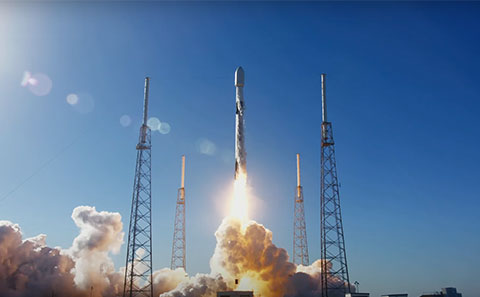First University plasma thrusters launched into orbit

An invention by Southampton researchers that will enable satellites to deorbit safely has launched into space for the first time.
The invention, designed by Dr Minkwan Kim Associate Professor in Astronautics at the University of Southampton, is a plasma thruster - a deorbiting propulsion system that can be stuck to the side of a small satellite.
The system will provide a tiny amount of thrust, equivalent to the weight of a feather, to enable the safe and controlled removal of end-of-life satellites from busy orbits. It will reduce the deorbiting timescale of satellites from over 100 years to about two years and will prevent deorbiting satellites from spinning too fast and breaking up or damaging other satellites, and thus reduce space debris.
The system is designed for CubeSats, which are miniature satellites used for space research. There are hundreds of CubeSats in orbit, used for applications such as remote sensing or communications.
The plasma thruster was launched on board a SpaceX Falcon 9 rocket from Cape Canaveral Space Force Station in Florida, USA, on 3 January 2023.
Watch our video with Dr Minkwan Kim.
Dr Minkwan Kim said: “This is an exciting moment for University of Southampton and our industry partner, Magdrive. Our research team has worked hard to develop a novel thin-layer vacuum arc thruster, known as ALPS (ALl-printed Propulsion System).
"ALPS is a unique micropropulsion system developed for a nanosatellite with the support of European Space Agency. The launched thruster is the machined version of ALPS for demonstrating its concept, and we thrilled to see it perform so well in orbit.
"We look forward to continuing to push the boundaries of what is possible in the field of micropropulsion technology.”
Dr Kim and his team will begin studying the effect of the thruster in the coming months.
He said: “The host spacecraft operators Endurosat are currently commissioning the spacecraft. Magdrive will then be able to commission the payload and slowly bring the voltage up to the point where the thruster is firing.
He continued: "We will then perform a series of tests on our control system, demonstrating fine control over the thruster, and measure the torque induced on the host spacecraft.”
At the end of the satellite’s five-year mission, it will be deorbited and will burn up upon re-entering the Earth’s atmosphere.
Hugh Lewis, Professor of Astronautics and an expert on space debris and space sustainability, added: “Quickly de-orbiting a spacecraft at the end of its mission is vital for reducing the risk of a collision, which would help other users of space and prevent the generation of even more space debris.
"The demonstration of this thruster represents an important step toward having this capability for CubeSats, which represent a substantial proportion of satellites in Earth orbit.”
According to the European Space Agency, there are an estimated 36,500 space debris objects in orbit that are greater than 10cm, one million that measure 1cm to 10cm, and 130 million that measure 1mm to 1cm.